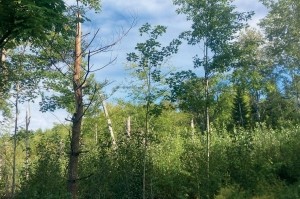
Forest succession is the process of forest development, a series of stages through which forests progress, each stage following – succeeding – the last. It is tempting to think of succession as a straight line, a one-way journey from young (early-successional) forest to old (late-successional) forest. However, like so many things related to forests, the reality is more complex. Succession is more cyclical than linear, with many detours and false-starts along the way.
In a landscape in which old forests are uncommon, there is lots of interest in managing relatively young forests to be more like late-successional forests. While there is value to this work, it is important to remember that each stage of succession is normal, natural, and essential – and each provides habitats that our native flora and fauna have adapted to for millennia. As with late-successional forest, early-successional forest is underrepresented in our region. Thoughtful management for early-successional habitat can be another way to enhance biodiversity across our landscape.
Early-successional forests are an explosion of life: a brief, diverse moment in forest development that follows a large-scale disturbance such as a hurricane, forest fire, insect or disease outbreak, tornado, or derecho. These disturbances make lots of light, moisture, and nutrients available, providing opportunities for a wide variety of tree species – including shade-intolerant trees such as aspen (poplar), paper birch, and pin cherry – as well as a diversity of native shrubs and herbaceous plants. These early successional species provide food and shelter for everything from butterflies to bobcats, and offer habitat important to a number of bird species that are declining in our region.
One way to create early-successional forest through management is to create a patch cut – an area at least two acres in size in which all or nearly all the trees are cut. This treatment is not appropriate everywhere, such as on steep slopes, areas with sensitive soils, and areas that are already home to important habitats such as deer yards and in old forests. Forest managers should also be wary of making patch cuts where invasive plants, such as non-native honeysuckle and buckthorn, are established, because a sudden influx of light, coupled with site disturbance, will almost certainly cause them to spread. If invasives are established, controlling them – preferably for several growing seasons – before creating a patch cut can prevent future problems. Finally, forest managers and landowners should consider the surrounding landscape; if early-successional habitat is already abundant in an area, it may not be necessary to create more. A forester can help determine where patch cuts are appropriate, and where to place them for maximum benefit.
When deciding where to place a patch cut on my land, I look for degraded stands, areas with some mature trees, and especially for areas with aging aspen trees. Aspen is the superstar of the early-successional forest, producing prodigious, fast-growing root sprouts when cut, thereby creating early-successional forest quickly and reliably.
In the forests that I manage, my goal is to create complex early-successional forest. The early-successional forests that occurred on our landscape for thousands of years would have been covered in fallen trees, tip-up mounds, snags, and legacy trees – a variety of structural conditions collectively known as complexity. Each of these features enriches habitat, which creates food and shelter for different flora and fauna, essentially inoculating a young forest with some of the elements of an old forest.
When creating a complex patch cut, I leave lots of trees (usually low-value trees) and dead wood on the ground. As it decomposes, this dead wood will help stabilize soils and attenuate erosion, improve soil fertility, and provide habitat for rodents, salamanders, invertebrates, fungi, and even young trees. I leave legacy trees and clusters of legacy trees to provide perch, nest, and den sites; cover; habitat for cavity-nesters; and a seed-source for future generations of trees. Some of these legacy trees will die and become a source of dead wood and tip-ups, providing seedbeds for tree species including yellow birch and hemlock. Others will persist as the young forest develops, providing unique habitats and ecological benefits for decades or even centuries to come.
Creating complex early-successional forest can be a tool for doing several things at once: regenerating areas of unhealthy forest, harvesting mature trees, and providing unique habitat. Used thoughtfully, in tandem with many other practices, and as part of a long-term silvicultural strategy, creating complex early successional habitat can be an important part of managing for healthy, functional, biologically diverse landscapes.

